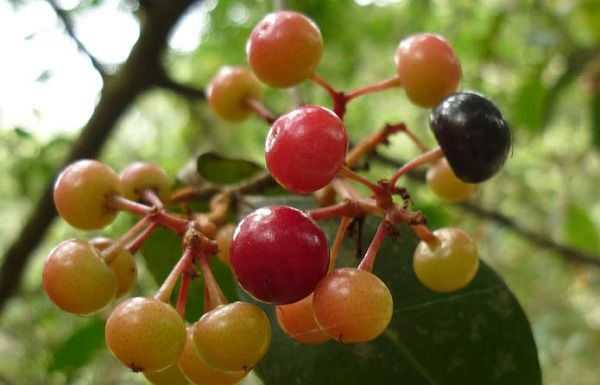Puerto Vallarta, Mexico - Gondos (Ardisia compressa Kunth) are an oft-overlooked endemic berry that grows prolifically in the cerro of Puerto Vallarta and Cabo Corrientes. The yellow flowers arrive in late winter and slowly bear fruit that is ready to pick just about now as we enter springtime.
Gondos are most often made into an agua fresca; they are an acquired taste but relished among locals for their tart, refreshing and medicinal qualities. Indigenous peoples revere gondos for their ability to heal coughs and liver problems. It's mouth-puckering, saliva-stimulating qualities suggest it's rich in tannins, which is also why it makes a good wine.
In Mascota and eastward over the mountains, the Gondo is called Faisan and made into a deep purple liqueur that ostensibly also heals what ails. The bright red-purple color signifies it is rich in anthocyanins, the same red pigment found in blueberries and huckleberries for example, that have significant antioxidant and thus, anti-"rust" effects on an aging body.
In the laboratory, Gondo leaf tea has been shown to inhibit cancer of the liver, making it an excellent tea for those recovering from Hepatitis B or alcohol abuse.
To prepare agua fresca, collect the dark purple berries early in the am, leaving the red berries to ripen a few days longer. Place them in a bowl and add water and use your hands to squeeze the fruit off and separate it from the seeds; Then strain and add water to taste: The more concentrated the juice, the more medicinal; more water will provide a delightful agua fresca.
Some think the fruit tastes like honey but you may decide for yourself if it needs to be sweetened. Make it and drink it within the first two days of collection, unless you wish to make vinegar or wine.
Remember, many areas of our dry forest are in danger, so make sure you collect with someone who knows the forest, knows the gondo, and only collect the berries, leaving some or the birds.
 Dr. Leslie Korn is an educator and clinician-healer specializing in complementary/alternative medicine and indigenous healing methods, who has been conducting research in the Banderas Bay and Cabo Corrientes regions since 1973. To learn more about her work, visit DrLeslieKorn.com.
Dr. Leslie Korn is an educator and clinician-healer specializing in complementary/alternative medicine and indigenous healing methods, who has been conducting research in the Banderas Bay and Cabo Corrientes regions since 1973. To learn more about her work, visit DrLeslieKorn.com.Click HERE to read more articles by Leslie Korn.



